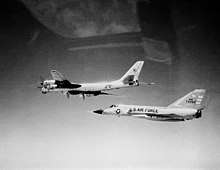Convair F-106 Delta Dart
The Convair F-106 Delta Dart was the primary all-weather interceptor aircraft of the United States Air Force from the 1960s through to the 1980s. Designed as the so-called "Ultimate Interceptor", it proved to be the last dedicated interceptor in U.S. Air Force service to date. It was gradually retired during the 1980s, with the QF-106 drone conversions of the aircraft being used until 1998 under the Pacer Six program.[3][4][5]
| F-106 Delta Dart | |
|---|---|
.png) | |
| A Convair F-106 of the California Air National Guard | |
| Role | Fighter interceptor |
| Manufacturer | Convair |
| First flight | 26 December 1956 |
| Introduction | June 1959 |
| Retired | August 1988 (ANG); 1998 (NASA) |
| Primary users | United States Air Force Air National Guard |
| Number built | 342 (2 prototypes, 277 F-106A, 63 F-106B) |
| Unit cost | |
| Developed from | Convair F-102 Delta Dagger |
Design and development
The F-106 was the ultimate development of the USAF's 1954 interceptor program of the early 1950s. The initial winner of this competition had been the F-102 Delta Dagger, but early versions of this aircraft had demonstrated extremely poor performance, limited to subsonic speeds and relatively low altitudes. During the testing program the F-102 underwent numerous changes to improve its performance, notably the application of the area rule to the fuselage shaping and a change of engine, and the dropping of the advanced MX-1179 fire control system and its replacement with a slightly upgraded version of the MX-1 already in use on subsonic designs. The resulting aircraft became the F-102A, and in spite of being considered barely suitable for its mission, the Air Force sent out a production contract in March 1954, with the first deliveries expected in the following year.[6][7]
By December 1951 the Air Force had already turned its attention to a further improved version, the F-102B. Initially the main planned change was the replacement of the A-model's Pratt & Whitney J57 (itself replacing the original J40) with the more powerful Bristol Olympus, produced under license as the Wright J67. By the time this would be available, the MX-1179 was expected to be available, and was selected as well. The result would be the "ultimate interceptor" the Air Force wanted originally. However, while initial work on the Olympus appeared to go well, by August 1953 Wright was already a full year behind schedule in development. Continued development did not resolve problems with the engine, and in early 1955 the Air Force approved the switch to the Pratt & Whitney J75.[8][N 1]
The J75 was somewhat larger than the J57 in the F-102A, and had greater mass flow. This demanded changes to the inlets to allow more airflow, and this led to the further refinement of using a variable-geometry inlet duct to allow the intakes to be tuned to best performance across a wide range of supersonic speeds. This change also led to the ducts being somewhat shorter. The fuselage grew slightly longer, and was cleaned up and simplified in many ways. The wing was slightly enlarged in area, and a redesigned vertical tail surface was used. The engine's 2-position afterburner exhaust nozzle was also used for idle thrust control. The nozzle was held open reducing idle thrust by 40% giving slower taxiing and less brake wear.[9]
A mock-up with the expected layout of the MX-1179, now known as the MA-1, was inspected and approved in December 1955. With growing confidence that the aircraft was now improving, an extended production contract for 17 F-102Bs was sent out on 18 April 1956. On 17 June, the aircraft was officially re-designated as the F-106A.[10][11][12]
The first prototype F-106, an aerodynamic test bed, flew on 26 December 1956 from Edwards Air Force Base, with the second, fitted with a fuller set of equipment, following 26 February 1957.[13] Initial flight tests at the end of 1956 and beginning of 1957 were disappointing, with performance less than anticipated, while the engine and avionics proved unreliable. These problems, and the delays associated with them, nearly led to the abandoning of the program,[13][14] but the Air Force decided to order 350 F-106s instead of the planned 1,000. After some minor redesign, the new aircraft, designated F-106A, were delivered to 15 fighter interceptor squadrons along with the F-106B two-seat combat-capable trainer variant, starting in October 1959.[15]
On 15 December 1959, Major Joseph W. Rogers set a world speed record of 1,525.96 mph (2,455.79 km/h) in a Delta Dart at 40,500 ft (12,300 m).[16][17][18] That year, Charles E. Myers flew the same model aircraft at 1,544 mph (2484 km/h).[19]
The F-106 was envisaged as a specialized all-weather missile-armed interceptor to shoot down bombers. It was complemented by other Century Series fighters for other roles such as daylight air superiority or fighter-bombing. To support its role, the F-106 was equipped with the Hughes MA-1 integrated fire-control system, which could be linked to the Semi-Automatic Ground Environment (SAGE) network for ground control interception (GCI) missions, allowing the aircraft to be steered by controllers. The MA-1 proved extremely troublesome and was eventually upgraded more than 60 times in service.[20]
Similar to the F-102, the F-106 was designed without a gun, or provision for carrying bombs, but it carried its missiles in an internal weapons bay for clean supersonic flight. It was armed with four Hughes AIM-4 Falcon air-to-air missiles, along with a single GAR-11/AIM-26A Falcon nuclear-tipped semi-active radar homing (SARH) missile (which detected reflected radar signals), or a 1.5 kiloton-warhead AIR-2 (MB-2) Genie air-to-air rocket intended to be fired into enemy bomber formations.[21] Like its predecessor, the F-102 Delta Dagger, it could carry a drop tank under each wing.[22] Later fighters such as the McDonnell Douglas F-4 Phantom II and McDonnell Douglas F-15 Eagle carried missiles recessed in the fuselage or externally, but stealth aircraft would re-adopt the idea of carrying missiles or bombs internally for reduced radar signature.
Ejection seats
The first ejection seat fitted to early F-106s was a variation of the seat used by the F-102 and was called the Weber interim seat. It was a catapult seat which used an explosive charge to propel it clear of the aircraft. This seat was not a zero-zero seat and was inadequate for ejections at supersonic speeds as well as ground level ejections and ejections at speeds below 120 knots (140 miles per hour; 220 kilometres per hour) and 2,000 feet (610 metres). The second seat that replaced the Weber interim seat was the Convair/ICESC (Industry Crew Escape System Committee) Supersonic Rotational B-seat, called the supersonic "bobsled", hence the B designation.[23] It was designed with supersonic ejection as the primary criterion since the F-106 was capable of Mach-2 performance. Fighter pilots viewed high speed ejections as the most important. Seat designers viewed an ejection at low altitude and slow speed as the most likely possibility. The ejection sequence with the B-seat was quite complicated and there were some unsuccessful ejections that resulted in pilot fatalities. The third seat, that replaced the Convair B-seat, was the Weber Zero-Zero ROCAT (for Rocket Catapult) seat. Weber Aircraft Corporation designed a "zero-zero" seat to operate at up to 600 knots (690 miles per hour; 1,100 kilometres per hour). High-altitude supersonic ejections were rare and ejections at relatively low altitudes and low speeds were more likely. The Weber "zero-zero" seat was satisfactory and was retrofitted to the F-106 after 1965.[24]
Operational history
The F-106 served in the contiguous US, Alaska, and Iceland, as well as for brief periods in Germany and South Korea. The F-106 was the second highest sequentially numbered P/F- aircraft to enter service under the old number sequence (the F-111 was highest), before the system was reset under the 1962 United States Tri-Service aircraft designation system. In service, the F-106's official name, "Delta Dart," was rarely used, and the aircraft was universally known simply as "The Six."[25]
Although contemplated for use in the Vietnam War the F-106 never saw combat, nor was it exported to foreign users. Following the resolution of initial teething problems – in particular an ejection seat that killed the first 12 pilots to eject from the aircraft [26] – its exceptional performance made it very popular with its pilots. After the cancellation of their own Avro Arrow, the Canadian government briefly considered purchasing the F-106C/D.
In an effort to standardize aircraft types, the USAF was directed to conduct Operation Highspeed, a flyoff competition between the USAF F-106A and the U.S. Navy F4H-1 (F-4B) Phantom, which was not only as capable as the F-106 as a missile-armed interceptor, but could also carry as large a bomb load as the Republic F-105 Thunderchief fighter-bomber.[27] The Phantom was the winner, but would first be tasked to escort and later replace the F-105 fighter-bomber in the late 1960s before replacing older interceptors in Air Defense Command in the 1970s.
The F-106 was progressively updated in service, with improved avionics, a modified wing featuring a noticeable conical camber, an infrared search and track system, streamlined supersonic wing tanks which provided virtually no degradation to overall aircraft performance, better instrumentation, and features like an inflight refuelling receptacle and an arrestor hook for landing emergencies.[28]
Air-to-air combat testing suggested "The Six" was a reasonable match for the McDonnell Douglas F-4 Phantom II in a dogfight, with superior high-altitude turn performance and overall maneuverability (aided by the aircraft's lower wing loading). However, the Phantom had better radar – operated by an additional crewman – and could carry a load of up to four radar-guided AIM-7 Sparrow and four infrared AIM-9 Sidewinder missiles, while the AIM-4 Falcon missiles carried by the F-106 proved a disappointment for dogfighting over Vietnam.[29] The F-4 had a higher thrust/weight ratio with superior climb, better high speed/low-altitude maneuverability, and could be used as a fighter-bomber. Air combat experience over Vietnam showed the need for increased pilot visibility and the utility of a built-in gun, which had been added to the "E" variant of USAF Phantoms.
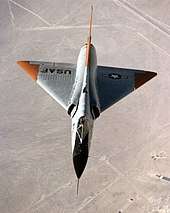
In 1972, some F-106As were upgraded in Project Six Shooter that involved fitting the F-106 with a new canopy without metal bracing[30] which greatly improved pilot visibility. Also added was an optical gunsight, and provision for a single M61 Vulcan 20 mm cannon. The M61 Vulcan had 650 rounds of ammunition in the center weapons bay and it replaced the AIM-26 Super Falcon or Genie.
The F-15A started replacing the F-106 in 1981, with "The Sixes" typically passed on to Air National Guard units. The F-106 remained in service in various USAF and ANG units until 1988.[3]
Retirement and conversion into drones
Between 1 June 1983 and 1 August 1988 the Delta Darts were incrementally retired and sent to the Military Storage and Disposition Center in Arizona.[31][32] When the need for a high performance Full Scaled Aerial Target Drone was required the USAF began withdrawing Delta Darts from storage. Starting in 1986, 194 of the surviving surplus aircraft were converted into target drones and these were designated QF-106As and used for target practice vehicles under the Pacer Six Program by the Aerial Targets Squadron.[33] The last was destroyed in January 1998.[4][5] The drones were still capable of being flown as manned aircraft, such as for ferrying to a test; during the test they were flown unmanned.[34] The QF-106 replaced the QF-100 Super Sabre drone; the last shoot down of a QF-106 (57-2524) took place at Holloman AFB on 20 February 1997 after which the QF-106 was superseded by the QF-4S and QF-4E Phantom II drone.
NASA research and test aircraft
Six F-106s were retained by NASA for test purposes through 1998. An F-106B two-seat trainer was operated by NASA Langley Research Center between 1979 and 1991.[35] This Delta Dart was used in research programs ranging from testing supersonic engines to improving maneuverability of fighters. Between 1980 and 1986 the aircraft was modified for the purpose of lightning strike research and became known as the Lightning Strike Plane and was struck 714 times without damage.[36][37] On one hour-long flight at 38,000 feet (12,000 metres) in 1984, lightning struck the research aircraft 72 times.[38] One significant modification was the replacement of the composite nose radome by a metallic radome. Although the maximum speed of the F-106 was Mach 2.3, during the lightning experiments it was flown at subsonic speeds into clouds at 300 knots (350 miles per hour; 560 kilometres per hour) from 5,000 to 40,000 feet (1,500 to 12,200 metres).[39] The aircraft was equipped with optical sensors which consisted of a video camera and a light detector. Data acquisition was performed with 1980s state of the art digital waveform recorders.
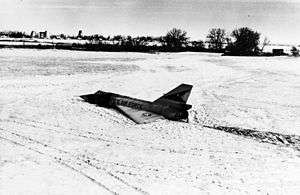
Eclipse project
NASA used six drones in its Eclipse Project which ran from 1997–1998.[40][41] The Dryden Flight Research Center supported project Eclipse which sought to demonstrate the feasibility of a reusable Aerotow-launch vehicle. The objective was to tow, inflight, a modified QF-106 aircraft with a C-141A transport aircraft. The test demonstrated the possibility of towing and launching a space launch vehicle from behind a tow plane.[42][43]
The Cornfield Bomber
On 2 February 1970, an F-106 of the 71st Fighter-Interceptor Squadron, piloted by Captain Gary Foust, entered a flat spin over Montana. Foust followed procedures and ejected from the aircraft. The resulting change of balance caused the aircraft to stabilize and later land "wheels up" in a snow-covered field, suffering only minor damage. The aircraft, promptly nicknamed "The Cornfield Bomber", was then sent back to base by rail, repaired and returned to service, and is now on display at the National Museum of the United States Air Force.[44]
Variants
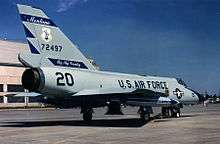
- F-102B: The original designation of the F-106A.
- F-106A: (Convair Model 8-24) Improved version of the F-102. Fitted with the MA-1 Integrated Fire Control System with SAGE datalink, J-75 afterburning turbojet, enlarged intake, variable-geometry inlet ramps and shortened intake ducts, refined fuselage shape, modified wings and redesigned tailfin; tailpipe fitted with a device to reduce the tendency of the jet exhaust to blow unsecured objects around while taxiing, yet allowing virtually maximum performance at high thrust settings including afterburner. Performance was deemed unsatisfactory and modifications were made. The aircraft was capable of low supersonic speeds without afterburner (but with a significant range penalty) and had a maximum altitude at least 57,000 ft (17,000 m). Many were fitted with a conically-cambered wing for improved takeoff, supersonic and high-altitude flight. To improve the aircraft's range the aircraft was fitted with two streamlined external supersonic tanks that still kept the aircraft capable of sustained roll rates of 100 degrees per second. Since these tanks produced virtually no significant performance degradation they were rarely jettisoned and were routinely carried around. After 1972, many F-106s were refitted with a new canopy featuring improved visibility, improved optic sights and provision for a gunpack in the center weapons bay.
- F-106B: (Convair Model 8-27) Two-seat, combat-capable training version. Pilot and instructor are seated in tandem. Due to the extra seat, the fuselage is actually better area ruled; combined with a likely reduction in weight.[45][N 2] Weapons configurations same as F-106A.
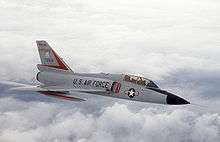 A two-seat F-106B trainer variant of the New Jersey ANG
A two-seat F-106B trainer variant of the New Jersey ANG - NF-106B: This designation was given to two F-106Bs used as test aircraft with NASA and associated research facilities from 1966 to 1991.[46]
- F-106C: Unbuilt version. Aircraft was intended to have the AN/ASG-18 radar and fire control system fitted originally developed for the North American XF-108 Rapier. For its time, it was the largest radar to ever be fitted to a fighter, actually requiring hydraulic actuators to turn the antenna. To accommodate this larger radar system, the nose cone was longer and of greater diameter. The design featured an improved raised canopy design featuring better visibility, canards and lengthened rectangular inlet ducts. The aircraft was to be capable of carrying one GAR-9/AIM-47A in its center bay and one AIM-26A in each side bay. At one time, the US Air Force had considered acquiring 350 of these advanced interceptors, but the F-106C/D project was cancelled on 23 September 1958.[47] [N 3]
- F-106D: Unbuilt two-seat version of the F-106C.
- F-106X: Unbuilt version (early 1968). It would have been outfitted with canards and powered by a JT4B-22 turbojet. It was envisioned as an alternative to the Lockheed YF-12, and was to have had a fire control system with "look-down/shoot-down" capability fed by a 40-inch radar dish.[17]
- F-106E: Unbuilt version. On 3 September 1968, Convair issued a proposal for an "improved" interceptor that was to be designated F-106E/F. It was to be compatible with the upcoming airborne warning and control systems as well as with the "over-the-horizon" radar defense network. The F-106E/F would have had a longer nose and a new and improved radar with a look-down/shoot-down tracking and missile launch capability. It would also have had a two-way UHF voice and datalink radio. It would have been capable of launching both nuclear and non-nuclear missiles, including the AIM-26 Nuclear Falcon and the AIM-47.[48]
- F-106F: Unbuilt two-seat version of the F-106E.
- QF-106A: Converted into drones, were still capable of being flown both as manned and unmanned aircraft.
- F-106 RASCAL Project: Unbuilt version. It would have been a low cost satellite launcher.[49]
Operators
|
|
Aircraft on display

- F-106A
- 56-0451 – Selfridge Military Air Museum, Selfridge Air National Guard Base, Michigan.[51]
- 56-0454 – Holloman AFB, New Mexico.[52]
- 56-0459 – McChord Air Museum, McChord AFB, Washington.[53]
- 56-0460 – Minot AFB, North Dakota.[54]
- 56-0461 – K. I. Sawyer AFB Heritage Air Museum at the former K. I. Sawyer AFB / now Sawyer International Airport, Marquette, Michigan.[55]
- 57-0230 – 125th Fighter Wing, Jacksonville Air National Guard Base at Jacksonville International Airport, Florida.[56]
- 58-0774 – Hill Aerospace Museum, Hill AFB, Utah.[57]
- 58-0787 – National Museum of the United States Air Force, Wright-Patterson AFB, Dayton, Ohio. Nicknamed the "Cornfield Bomber", this F-106 landed itself with relatively minor damage in a farmer's field after its pilot lost control and ejected. It last served with the 49th Fighter Squadron before being brought to the museum in August 1986.[58]
- 58-0793 – Castle Air Museum at the former Castle AFB, Atwater, California.[59]
- 59-0003 – Pima Air & Space Museum, adjacent to Davis-Monthan AFB in Tucson, Arizona.[60]
- 59-0010 – Aerospace Museum of California, McClellan Airfield (former McClellan AFB), Sacramento, California.[61]
- 59-0023 – Air Mobility Command Museum, Dover AFB, Delaware.[62]
- 59-0043 – 309th Aerospace Maintenance and Regeneration Group, Davis-Monthan AFB, Arizona.[63]
- 59-0069 – Great Falls Air National Guard Base, Great Falls Airport, Montana.[64]
- 59-0086 – Pacific Coast Air Museum, Santa Rosa, California.[65]
- 59-0105 – Camp Blanding Museum, Camp Blanding Florida National Guard Joint Training Center, Middleburg, Florida.[66]
- 59-0123 – Museum of Aviation, Robins AFB, Warner Robins, Georgia.[67]
- 59-0134 – Peterson Air and Space Museum, Peterson AFB, Colorado Springs, Colorado.[68]
- 59-0137 – Evergreen Aviation & Space Museum, McMinnville, Oregon.[69]
- 59-0145 – Tyndall Air Park, Tyndall AFB, Florida.[70]
- 59-0146 – 144th Fighter Wing, Fresno Air National Guard Base, Fresno, California.[71]
- F-106B
- 57-2513 – Yanks Air Museum, Chino, California.[72]
- 57-2523 – Atlantic City Air National Guard Base, Atlantic City, New Jersey.[73]
- 57-2533 – Kelly Field Heritage Museum, Lackland AFB/Kelly Field (former Kelly AFB), Texas.[74]
- 59-0158 – Edwards AFB Century Circle, Edwards AFB, California.[75]
- NF-106B
- 57-2516 – Virginia Air and Space Center / Hampton History Center, Hampton, Virginia.[76]
Specifications (F-106A)
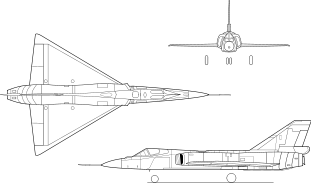
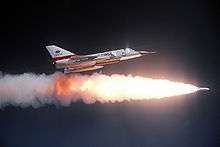
Data from Quest for Performance[77], Convair Deltas[78]
General characteristics
- Crew: 1
- Length: 70 ft 8 in (21.55 m)
- Wingspan: 38 ft 3 in (11.67 m)
- Height: 20 ft 3 in (6.18 m)
- Wing area: 661.5 sq ft (61.46 m2) Original Wing
- 695 sq ft (65 m2) Conically-Cambered Wing
- Aspect ratio: 2.1
- Airfoil: NACA 0004-65 mod [79]
- Empty weight: 24,420 lb (11,077 kg)
- Gross weight: 34,510 lb (15,653 kg)
- Powerplant: 1 × Pratt & Whitney J75-P-17 afterburning turbojet engine, 16,100 lbf (72 kN) thrust dry, 24,500 lbf (109 kN) with afterburner
Performance
- Maximum speed: 1,325 kn (1,525 mph, 2,454 km/h) at 40,000 ft (12,192 m)
- Maximum speed: Mach 2.3
- Combat range: 500 nmi (580 mi, 930 km) with internal fuel [80]
- Ferry range: 2,346 nmi (2,700 mi, 4,345 km) with external tanks at 530 kn (610 mph; 982 km/h) at 41,000 ft (12,497 m)[80]
- Service ceiling: 57,000 ft (17,000 m)
- Rate of climb: 29,000 ft/min (150 m/s)
- Time to altitude: 52,000 ft (15,850 m) in 6 minutes 54 seconds
- Lift-to-drag: 12.1 (Subsonic, est.)
- Wing loading: 52 lb/sq ft (250 kg/m2)
- Thrust/weight: 0.71
Armament
- Guns: 1 20 mm caliber M61A1 Vulcan 6-barreled rotary cannon (After 1972 refit)
- Missiles:
- 2 AIM-4F Falcon
- 2 AIM-4G Falcon
- 1 AIR-2A Genie nuclear rocket or AIM-26 Super Falcon missile (Prior to 1972 refit)
Avionics
- Hughes MA-1 AWCS - weapon system
See also
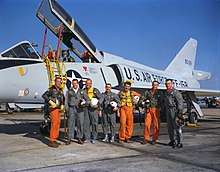
Related development
Aircraft of comparable role, configuration and era
- Avro Canada CF-105 Arrow
- Dassault Mirage III
- English Electric Lightning
- Mikoyan-Gurevich MiG-21/Chengdu J-7
- Saab 35 Draken
- Sukhoi Su-9/Su-11
- Sukhoi Su-15
Related lists
References
Notes
- The reason for Wright's problems adapting the Olympus are not well recorded. Bristol appears to have had a smooth time introducing the Olympus in British service, and the design would go on to serve for decades.
- It is uncertain if the F-106B was fitted with the modified "Project Sharpshooter" optic sights and gunpack provision.
- After the cancellation of the Avro Canada CF-105 Arrow, the Canadian government briefly considered purchasing the F-106C/D. After the F-106C/D project was canceled, it acquired McDonnell CF-101 Voodoos, instead.
Citations
- Knaack 1978
- "CPI Inflation Calculator". Archived from the original on 2011-03-15. Retrieved 2013-10-03. - This value is simply the 1973 cost adjusted for inflation, it does not account for any adjustments in individual prices for materials and what not.
- Winchester 2006, p. 55.
- "The "Pacer Six" Program". The 456th Fighter Interceptor Squadron. 1998-2014 www.F106DeltaDart.com. Archived from the original on 26 July 2014. Retrieved 16 July 2014.
- Knaak, Marcelle Size (1978). Encyclopedia of U.S. Air Force Aircraft and Missile Systems - Volume 1. Washington D.C.: Office of Air Force History. p. 164. ISBN 1478125535.
- Converse III, Elliott V. (2012-06-12). Rearming for the Cold War 1945 -- 1960. Washington D.C.: Defense Dept (U.S.). p. 241. ISBN 9780160911323.
- "History of the 'F-106 Delta Dart'". F-106DeltaDart.com. Convair Aircraft Plant San Diego, CA. Archived from the original on 22 July 2014. Retrieved 17 June 2014.
- Flight Manual F-106A and F-106B T.O. 1F106A-1 page 1-22 "Idle thrust control switch"
- "The Convair F-102A". 456FIS.ORG. THE 456th FIGHTER INTERCEPTOR SQUADRON. Archived from the original on 14 July 2014. Retrieved 17 June 2014.
- Writer, Staff. "Convair F-106 Delta Dart Interceptor Aircraft (1959) : The F-106 Delta Dart began life as the F-102 Delta Dagger". militaryfactory.com. Military Factory. Archived from the original on 1 July 2014. Retrieved 17 June 2014.
- "CONVAIR F-106A DELTA DART". The Official Web Site of National Museum of the USAF. National Museum of the US Air Force. Archived from the original on 14 September 2011. Retrieved 17 June 2014.
- Peacock 1986, p. 200.
- Wegg 1990, p. 209.
- Green 1964, p. 138.
- Drendel 1980, p. 92.
- Donald 2003, p. 232
- "U.S. Jet Sets 1,520.9-M.P.H. Speed Record", Oakland Tribune, 16 December 1959, p. 1.
- Samuel, Wolfgang (2015). In Defense of Freedom: Stories of Courage and Sacrifice of World War II Army Air Forces Flyers. University Press of Mississippi. ISBN 978-1-62846-217-3.
- Baugher, Joe. "Convair F-106A Delta Dart." Archived 2010-11-24 at the Wayback Machine USAAC/USAAF/USAF Fighter and Pursuit Aircraft: Convair F-106 Delta Dart, American Military Aircraft, 19 December 1999. Retrieved: 8 April 2011.
- Winchester 2006, p. 54.
- Taylor 1995, p. 93.
- Carey, Christopher T. "Ejectorseats History". ejectorseats.co.uk. AEOLUS AEROSPACE 5960 S. Land Park Drive, Suite 341 Sacramento, CA 95822-3313. Archived from the original on 29 May 2014. Retrieved 18 July 2014.
- Potvin, PhD, Jean. "The Convair F-106 "Delta Dart" Egress System" (PDF). lanset.com. Lanset America Corp. 10321 Placer Lane, Sacramento, CA. US. 95827. Archived from the original (PDF) on 8 August 2014. Retrieved 18 July 2014.
- "F-106 Delta Dart - History of the SIX". F-106DeltaDart.com. Convair Aircraft Plant San Diego, CA. Archived from the original on 22 July 2014. Retrieved 17 June 2014.
- Broughton 2007, p. 17.
- "F-106 Delta Dart." Archived 2014-12-20 at the Wayback Machine National Museum of the U.S. Air Force.
- Donald 2003, pp. 242, 246.
- Donald 2003, pp. 259–260.
- Donald 2003, p. 250.
- "McChord Air Museum Homepage- F-106 Delta Dart (s/n 56-0459) the 318th FIS's "Ultimate Interceptor" and the Fastest Single-Engine Fighter". The McChord Air Museum. The McChord Air Museum Foundation, McChord AFB, WA. Archived from the original on 22 March 2014. Retrieved 16 July 2014.
- "AMARC/AMARG Boneyard". F-106deltadart.com. 1998-2014 www.F-106deltadart.com. Archived from the original on 26 July 2014. Retrieved 16 July 2014.
- "QF-106 Drone 'Pacer Six Program' 1990–1998 Full-Scale Aerial Target (FSAT)". F-106DeltaDart.com. 1998-2014 F-106DeltaDart.com. Archived from the original on 26 July 2014. Retrieved 17 July 2014.
- Donald 2003, pp. 270–271.
- Laroche, Pierre; Delannoy, Alain; Blanchet, Patrice; Issac, François. "Lightning Hazards to Aircraft and Launchers - Experimental Studies of Lightning Strikes to Aircraft" (PDF). AerospaceLab-Journal.org. Aerospace Lab Journal Issue 5 December 2012 Experimental Studies of Lightning Strikes to Aircraft Page 3. Archived (PDF) from the original on 12 July 2014. Retrieved 18 July 2014.
- Saville, Kirk. "Lightning Strike Plane Gets Final Assignment Fighter Weathered 714 Lightning Bolts". The Daily Press Media Group, 7505 Warwick Blvd., Newport News, VA 23607 May 18, 1991. Retrieved 18 July 2014.
- "Lightning and the Space Program" (PDF). tstorm.com. John F. Kennedy Space Center Kennedy Space Center, Florida 32899 AC 321/867-2468 - FS-1998-08-16-KSC August 1998 Page 2. Archived (PDF) from the original on 4 March 2016. Retrieved 18 July 2014.
- Schmitt, Eric. "Jet Chases Lightning In Bid To Increase Safety". NYtimes.com. The New York Times September 29, 1985. Archived from the original on 26 July 2014. Retrieved 18 July 2014.
- "NASA Lightning Strike Research - NASA Storm Hazards Research Program". F-106DeltaDart.com. 1998-2014 F-106DeltaDart.com. Archived from the original on 26 July 2014. Retrieved 18 July 2014.
- "Archived copy" (PDF). Archived (PDF) from the original on 2010-01-12. Retrieved 2009-12-28.CS1 maint: archived copy as title (link)
- "NASA Dryden Past Projects: Eclipse Tow Launch Demonstration | NASA". Nasa.gov. 2009-08-31. Archived from the original on 2014-08-08. Retrieved 2014-08-07.
- Curry, Marty. "Eclipse EC97-44159-8: Eclipse program F-106 aircraft in flight Photo Collection". dfrc.nasa.gov. NASA Dryden Flight Research Center August 1997. Archived from the original on 23 September 2015. Retrieved 18 July 2014.
- Tucker, Tom. "The Eclipse Project" (PDF). NASA History Division, Office of Policy and Plans. U.S. Government Printing Office, Washington DC 20546. Archived (PDF) from the original on 12 January 2010. Retrieved 18 July 2014.
- "58-0787 Pilot-less Landing: 'Cornfield Bomber'." Archived January 6, 2011, at the Wayback Machine f-106deltadart.com. Retrieved: 31 December 2010.
- "Factsheets : Convair F-106B". NationalMuseum.af.mil. National Museum of the United States Air Force. Archived from the original on 3 September 2014. Retrieved 18 July 2014.
- Baugher, Joe. "Convair F-106B Delta Dart." Archived 2010-11-24 at the Wayback Machine USAAC/USAAF/USAF Fighter and Pursuit Aircraft: Convair F-106 Delta Dart, American Military Aircraft, 18 December 1999. Retrieved: 8 April 2011.
- Baugher, Joe. "Convair F-106C/D Delta Dart." Archived 2010-11-24 at the Wayback Machine USAAC/USAAF/USAF Fighter and Pursuit Aircraft: Convair F-106 Delta Dart, American Military Aircraft, 18 December 1999. Retrieved: 8 April 2011.
- "F-106C/D/E/F." Archived 2007-02-04 at the Wayback Machine Air To Air Combat. Retrieved: 8 April 2011.
- "RASCAL Project". F-106 Delta Dart. Archived from the original on 2014-01-16. Retrieved 2014-03-04.
- Baugher, Joe. "F-106 Squadron Assignments." Archived 2012-06-05 at the Wayback Machine USAAC/USAAF/USAF Fighter and Pursuit Aircraft: Convair F-106 Delta Dart, American Military Aircraft, 18 December 1999. Retrieved: 12 January 2012.
- "F-106 Delta Dart/56-0451." Archived 2016-03-03 at the Wayback Machine Selfridge Air Museum. Retrieved: 27 January 2015.
- "F-106 Delta Dart/56-0454." Archived 2015-05-30 at the Wayback Machine aerialvisuals.ca Retrieved: 27 January 2015.
- "F-106 Delta Dart/56-0459." Archived 2014-03-22 at the Wayback Machine McChord Air Museum. Retrieved: 7 November 2012.
- "F-106 Delta Dart/56-0460." Archived 2016-03-04 at the Wayback Machine aerialvisuals.ca Retrieved: 27 January 2015.
- "F-106 Delta Dart/56-0461." Archived 2015-02-17 at the Wayback Machine K.I. Sawyer Heritage Air Museum. Retrieved: 27 January 2015.
- "F-106 Delta Dart/57-0230." Archived 2016-01-31 at the Wayback Machine aerialvisuals.ca Retrieved: 27 January 2015.
- "F-106 Delta Dart/58-0774." Archived 2011-06-22 at the Wayback Machine Hill Aerospace Museum. Retrieved: 7 November 2012.
- "F-106 Delta Dart/58-0787." Archived 2016-11-22 at the Wayback Machine National Museum of the USAF. Retrieved: 23 August 2015.
- "F-106 Delta Dart/58-0793." Archived 2015-01-13 at the Wayback Machine Castle Air Museum. Retrieved: 27 January 2015.
- "F-106 Delta Dart/59-0003." Archived 2015-06-17 at the Wayback Machine Pima Air & Space Museum. Retrieved: 17 June 2015.
- "F-106 Delta Dart/59-0010." Archived 2015-03-28 at the Wayback Machine Aerospace Museum of California. Retrieved: 27 January 2015.
- "F-106 Delta Dart/59-0023." Archived 2015-05-16 at the Wayback Machine Air Mobility Command Museum. Retrieved: 7 November 2012.
- "F-106 Delta Dart/59-0043." Archived 2015-07-22 at the Wayback Machine aerialvisuals.ca Retrieved: 27 January 2015.
- "F-106 Delta Dart/59-0069." Archived 2015-07-13 at the Wayback Machine aerialvisuals.ca Retrieved: 27 January 2015.
- "F-106 Delta Dart/59-0086." Archived 2012-06-25 at the Wayback Machine Pacific Coast Air Museum. Retrieved: 7 November 2012.
- "F-106 Delta Dart/59-0105." Archived 2015-02-04 at the Wayback Machine Camp Blanding Museum. Retrieved: 27 January 2015.
- "F-106 Delta Dart/59-0123." Archived 2012-12-03 at the Wayback Machine Museum of Aviation. Retrieved: 7 November 2012.
- "F-106 Delta Dart/59-0134." Archived 2015-01-27 at the Wayback Machine Peterson Air and Space Museum. Retrieved: 27 January 2015.
- "F-106 Delta Dart/59-0137." Archived 2011-12-06 at the Wayback Machine Evergreen Aviation & Space Museum. Retrieved: 7 November 2012.
- "F-106 Delta Dart/59-0145." Archived 2015-07-01 at the Wayback Machine aerialvisuals.ca Retrieved: 27 January 2015.
- "F-106 Delta Dart/59-0146." Archived 2015-06-17 at the Wayback Machine aerialvisuals.ca Retrieved: 17 June 2015.
- "Convair F-106B Delta Dart". Yanks Air Museum. 2017-01-28. Retrieved 2019-12-28.
- "F-106 Delta Dart/57-2523." Archived 2016-03-04 at the Wayback Machine aerialvisuals.ca Retrieved: 27 January 2015.
- "F-106 Delta Dart/57-2533." Archived 2015-06-03 at the Wayback Machine aerialvisuals.ca Retrieved: 27 January 2015.
- "F-106 Delta Dart/59-0158." Archived 2015-06-19 at the Wayback Machine aerialvisuals.ca Retrieved: 27 January 2015.
- "F-106 Delta Dart/57-2516." Archived 2017-03-18 at the Wayback Machine Virginia Air and Space Center. Retrieved: 27 January 2015.
- Loftin, L.K, Jr. "Quest for performance: The Evolution of Modern Aircraft." Archived 2006-06-13 at the Wayback Machine NASA SP-468. Retrieved: 22 April 2006.
- Yenne, Bill (2009). Convair Deltas : from Seadart to Hustler (1st ed.). North Branch, MN: Specialty Press. pp. 118-155. ISBN 9781580071185.
- Lednicer, David. "The Incomplete Guide to Airfoil Usage". m-selig.ae.illinois.edu. Retrieved 16 April 2019.
- "F-106 Delta Dart by Convair". www.f-106deltadart.com. Archived from the original on 25 November 2016. Retrieved 4 May 2018.
Bibliography
- Broughton, Jack. Rupert Red Two: A Fighter Pilot's Life from Thunderbolts to Thunderchiefs. Minneapolis, Minnesota: Zenith Press, 2007. ISBN 978-0-7603-3217-7.
- Carson, Don and Lou Drendel. F-106 Delta Dart in Action. Carrollton, Texas: Squadron/Signal Publications, 1974. ISBN 0-89747-014-1.
- Donald, David (June 2004). "Convair F-106 Delta Dart: The Ultimate Interceptor". Century Jets: USAF Frontline Fighters of the Cold War. London: AIRtime Publishing Inc., 2003. ISBN 1-880588-68-4.
- Drendel, Lou. Century Series in Color (Fighting Colors). Carrollton, Texas: Squadron/Signal Publications, 1980. ISBN 0-89747-097-4.
- Green, William. The World's Fighting Planes. London: Macdonald, 1964.
- Jenkins, Dennis R. and Tony R. Landis. Experimental & Prototype U.S. Air Force Jet Fighters. North Branch, Minnesota: Specialty Press, 2008. ISBN 978-1-58007-111-6.
- Knaack, Marcelle Size (1988). Encyclopedia of US Air Force Aircraft and Missile Systems: Volume 1 Post-World War II Fighters 1945–1973. Washington, D.C.: Office of Air Force History, 1978. ISBN 0-912799-59-5.
- Pace, Steve. X-Fighters: USAF Experimental and Prototype Fighters, XP-59 to YF-23. St. Paul, Minnesota: Motorbooks International, 1991. ISBN 0-87938-540-5.
- Peacock, Lindsay. "Delta Dart ... Last of the Century Fighters". Air International, Vol. 31, No 4, October 1986, pp. 198–206, 217. Stamford, UK: Fine Scroll.
- Taylor, Michael J. H., ed. "Convair Delta Dart". Jane's American Fighting Aircraft of the 20th Century. New York: Modern Publishing, 1995. ISBN 978-0-7924-5627-8.
- United States Air Force Museum Guidebook. Wright-Patterson AFB, Ohio: U.S. Air Force Foundation, 1975.
- Wegg, John. General Dynamic Aircraft and their Predecessors. London: Putnam, 1990. ISBN 0-85177-833-X.
- Winchester, Jim, ed. "Convair F-106 Delta Dart." Military Aircraft of the Cold War (The Aviation Factfile). London: Grange Books plc, 2006. ISBN 1-84013-929-3.
External links
| Wikimedia Commons has media related to Convair F-106 Delta Dart. |
